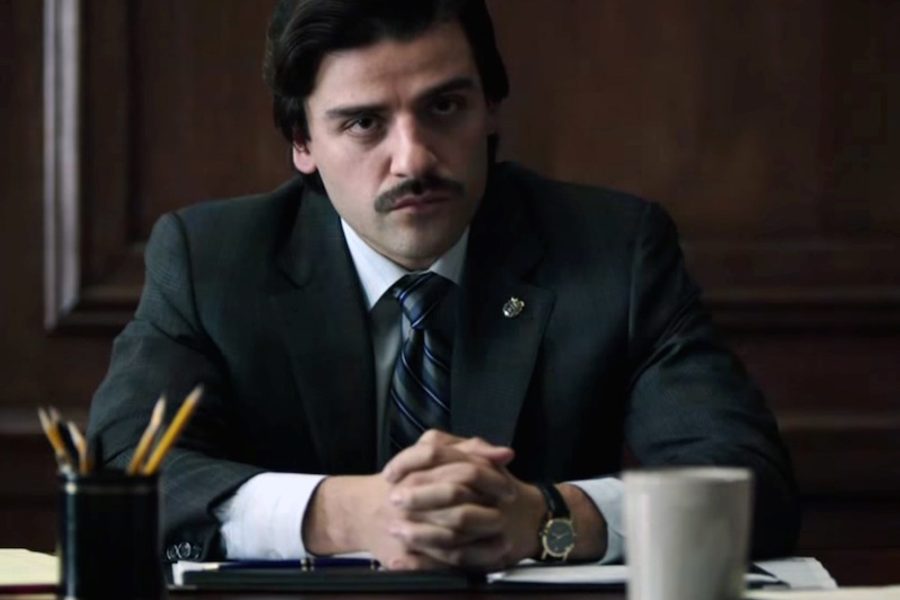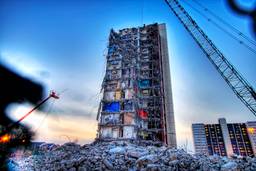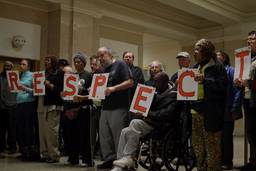‘The Wire’ Humanized Urban Black People. In ‘Show Me a Hero,’ David Simon Humanizes White Racists.
In a post-Ferguson America, David Simon’s Show Me a Hero feels sadly dated.
Maya Dukmasova

It’s hard to image a subject less worthy of dramatization than the petty struggle of a narcissistic white man to gain the attention and approval of a small, racist city. Yet that’s the lens The Wire creator David Simon chose for his 6-part mini-series for HBO (episodes 3 and 4 air tonight).
That’s a pity because Show Me a Hero centers on an interesting and relevant historical moment: how late-1980s Yonkers, N.Y., nearly destroyed itself over the construction of 200 units of public housing in white parts of town.
In 1985, a federal judge ruled that Yonkers had intentionally segregated its public housing and must build 200 units in white sections of the city. The residents of white, working-class East Yonkers, where the housing was to be built, promptly revolted. They set upon their elected officials with pickets, rocks and guns, demanding a halt to the plan. The simple facts of the city’s legal situation were completely lost on the enraged populace.
The city wasted millions of dollars on fruitless attempts to avoid compliance. In 1987, the appellate court ruled against Yonkers, and the Supreme Court refused to hear the case. Recalcitrant members of the city council continued to block votes on the exact location of the housing until the judge presiding over the case found Yonkers in contempt. He fined the city, quickly shutting down municipal services and bringing layoffs, which fed the ranks of the angry white community.
Telling this story could have been worthwhile if it explored the lives of the black people in Yonkers — the residents of the projects who faced the violent hostility of their white neighbors.
Yet Simon chose Nicholas J. Wasicsko as his main narrative focus: the 28-year-old who, in 1987, became the youngest mayor in America.
Wasicsko is presented at first as a charming young man without any real interests apart from the advancement of his political career. (That, and a cute girl working in City Hall). When he runs against a six-term incumbent, Wasicsko wins because the voters think he will successfully appeal the housing court order. When the city loses the legal the people turn on Wasicsko, believing that he has given up the fight and abandoned them to the impending horror of black neighbors.
Wasicsko, meanwhile, has suddenly come to believe that building the housing was the right thing to do. For a couple of episodes, he valiantly attempts to bypass the dissenting city councilmen. But his efforts ring hollow — his primary motivation appears to be retaining his office. It’s hard to miss the parallels to The Wire’s Baltimore Mayor Tommy Carcetti, who runs for office with idealistic aims and ends up selling out the schools for political gain. But Carcetti worked because the viewer truly placed hope in him as someone who could do better for the city, only to have those hopes dashed. With Wasicsko we never really buy it, even in the beginning. Despite the title of this series (a reference to an F. Scott Fitzgerald quote), Wasicsko is never shown as a hero — he’s always a self-interested politician above all else.
In fact, the series never shows us a hero. Nor does it show us any of the kind of well-rounded, complex black characters that abounded in The Wire.
Instead, the second most important character is Mary Dorman, a middle-aged woman who is on the front lines of the opposition to the housing. She persistently campaigns against the plans until — oh, miracle — she begins to discover that black people are people, too!
Unfortunately, Show Me a Hero does a better job channeling Dorman’s racism than challenging it. The show does very little to dismantle stereotypes about public housing or the people who live there.
When Dorman is recruited by the organization tasked with finding tenants for the new public housing, we accompany her through the old projects as though on safari. How fearful she is as she enters the dark stairwell, filled with suspicious black men who seem ready to snatch her purse. How horrified she is to see police slam those same men onto the hoods of their patrol cars outside. And how pleasantly surprised she is to discover that the fathers of project residents also served in the war, that their apartments are clean, and that they use cups and saucers to drink their tea.
For at least 50 years this woman lived with the conviction that people of color are deficient and immoral. Then she discovers that this is not so, and that stigmatizing them is wrong. Apparently our hearts are supposed to be warmed.
Perhaps the point was to depict the suffering inflicted by the city’s attempts to maintain segregation, and how deserving those in public housing were of the new accommodations. And indeed, we meet a disjointed cast of characters from the projects: A working mom of three from the Dominican Republic, a 47-year-old black woman going blind as a result of diabetes, and two young women who struggle to cope with unplanned pregnancies, drug addiction, and the loss of their men to asthma and prison, respectively. Like Dorman and Wasicsko, they are all based on real people in Yonkers.
None of these have-nots are unsympathetic. But they are ultimately clichéd, flat characters who do not appear to have any agency. We barely get to know their names. In the end, we don’t know anything more about what it’s really like to be poor and black than David Simon.
Even the show’s attempts to “humanize” poor people of color go subtly awry. We see them make bad decisions out of desperation, but there is scarcely a hint of the structural forces that limit their choices. At times they inexplicably pass up better options: One young woman, Doreen, comes from a stable household. Her parents are homeowners and yet she chooses to hang out at the projects and marry a drug dealer. Billie drops out of school even though her mom is a hard-working nurse.
One scene stands as a particularly wasted opportunity to show how residents of public housing persistently organized to take control of their living conditions. A group of women in the new townhouses gathers for a meeting, but no one wants to take the lead. They are apparently unaccustomed to coalescing around anything positive, only to complaining about things going wrong in their apartments. Doreen suggests that they throw an end-of-the-school-year party since their kids can no longer go on a trip sponsored by the housing authority on the West side. The others are skeptical. “I’m talking about really doing this together, doing things the way neighbors are supposed to,” she cajoles them. The women start to come around.
Anyone with an even cursory familiarity of public housing history or residents would know that the projects in Yonkers and elsewhere were always full of positive initiatives, especially by women. These were mounted in spite of leaky faucets, broken windows, and drug dealing in the stairwells, and without the help of housing authorities. They were mounted because the people in the projects always knew how to be neighbors. But all we are left with is the idea that the residents didn’t care about each other in the new townhomes because they didn’t do so in the projects. On the day of the barbeque, Doreen sits next to the grill by herself. Two kids play absentmindedly on the lawn.
Based on a 1999 book, and in development since 2002, Show Me a Hero feels like a dated intervention. Perhaps a few years ago we would have turned to it with curiosity. Perhaps a white audience could have been shocked and outraged as they watched how outraged some other white people were in the ‘80s at the prospect of having black neighbors.
But it’s 2015, and no American TV viewer can claim to be shocked at scenes of white folk vociferously and violently opposing integration. It’s enough to turn on the news. No one can pretend they don’t see how this country is as segregated as ever, and how this segregation is viciously maintained through police brutality and vigilantism.
Particularly inappropriate in light of everything that’s happened in the past year is Show Me a Hero’s implication that white people’s misgivings about black people might be justified, or at least relatable. By humanizing Dorman and the other “hardworking but misguided” residents of Yonkers, we are being asked to sympathize with the process of their growth. We are asked to commend them on their ability to get past their prejudices. The show ends on a note suggesting that racial reconciliation “takes time,” that it’s something people slowly grow accustomed to, almost in spite of themselves.
But Michael Brown did not have time. Trayvon Martin did not have time. Rekia Boyd did not have time. Clementa Pinckney and his fellow congregants did not have time. As ever, it is only white folk who can afford and are afforded the time to think through their hatred, the “tough issues of race,” to come to terms with difference and otherness, and risk nothing in the process.
Unlike The Wire, this lackluster mini-series will likely soon be forgotten, consigned to the annals of social studies lessons on 20th century U.S. history. At its best, it captures the sad reality that white people are quite willing to destroy their own community so as not to have to share it with people of color. It depicts a racism that lies apart from the physical violence inflicted on black and brown bodies and yet is intimately intertwined with it. It is a racism with agency. It courses through the American body politic and animates our way of life.
One character in the series who will probably go unnoticed is Oscar Newman, the white architect consultant who convinced the city that the new public housing had to be town houses instead of walk-ups or elevator towers. Not having “nebulous” public spaces like stairwells and lobbies (ever the mainstay in posh condo buildings across the nation) would encourage residents to take better care of their homes and be on the lookout for crime.
Newman is presented as a laconic technocrat who deftly maneuvers around the political upheavals of City Hall to push through his vision of the housing. He calls for an end to “concentrated poverty,” which in the context of the series seems all too reasonable. We don’t learn, however, how years later his theories would be used to eliminate hundreds of thousands of public housing units across the country and give way to the public-private partnerships that have enriched developers at the expense of the poor.
Now that would have been a show worth making: one illuminating the current, ongoing mechanisms of disenfranchisement and segregation. But what does the average HBO subscriber care that an architect’s ideas about how the poor should live, with little to no input from those people, has dramatically reshaped urban space and society in this country? Every city in America is full of today’s Mary Dormans. They are ignorant of history, unwilling to recognize how much the government has subsidized their own success, and hopelessly out of touch even when they’re well-intentioned. They’re all too happy that the projects are gone from their skylines. And if they think about it at all, they’re mostly convinced that poor people of color are better off today than they were 30 years ago. Show Me a Hero will teach them no different.
Maya Dukmasova is a senior writer at the Chicago Reader. Her articles and translations have appeared in Harper’s, Jacobin, Slate, the Appeal, Places Journal, the Chicago Reader, and the Chicago Tribune. Follow her on Twitter: @mdoukmas.







